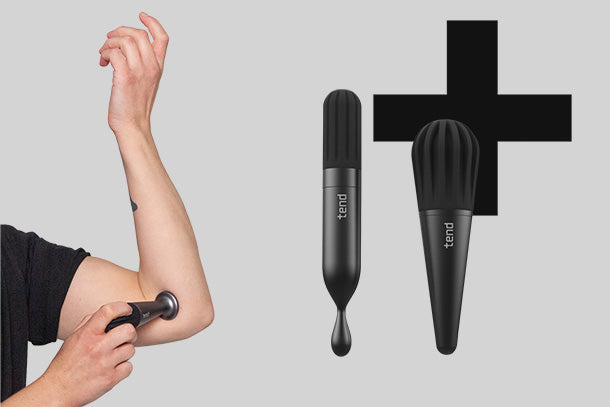The Evidence
How Does Tend work?
Tend uses Direct Vibration Therapy, sometimes known as Focal Vibration therapy.
What is unique about Tend?
Tend uses different vibration patterns for optimum results
Tend has a unique pin point tip to access hard to reach parts of the body
What is Focal Vibration Therapy?
Focal Vibration Therapy (FVT) is a type of therapy that involves the use of high-frequency vibrations to treat muscle and joint pain, stiffness, and other musculoskeletal conditions. This therapy is typically performed using a device that generates vibrations, which are then applied directly to the affected area of the body.
The theory behind FVT is that the vibrations stimulate sensory receptors in the muscles, tendons, and joints, which can help to reduce pain and improve flexibility and range of motion. The vibrations also increase blood flow to the affected area, which can promote healing and reduce inflammation.
FVT can be used to treat a wide range of musculoskeletal conditions, including:
- Osteoarthritis
- Plantar fasciitis
- Back pain
- Tennis elbow
- Carpal tunnel syndrome
- Shoulder pain
- Knee pain
What evidence is there that Focal Vibration Therapy is Effective?
There is some evidence to suggest that direct vibration therapy may be effective for certain conditions. For example, massage therapy, which involves the use of manual vibration and pressure, has been shown to be effective in reducing muscle pain and improving muscle function in people with conditions such as fibromyalgia, lower back pain, and knee osteoarthritis. Trigger point therapy, which involves applying localized pressure and vibration to specific points in the muscles, has also been found to be effective in reducing pain and improving mobility in people with chronic myofascial pain
What research is there to prove Focal Vibration Therapy is effective?
- Rittweger J, Mutschelknauss M, Felsenberg D. Acute changes in neuromuscular excitability after exhaustive whole body vibration exercise as compared to exhaustion by squatting exercise. Clinical Physiology and Functional Imaging. 2003;23(2):81-86. doi: 10.1046/j.1475-097x.2003.00488.x
https://onlinelibrary.wiley.com/doi/abs/10.1046/j.1475-097x.2003.00488.x
- Verschueren SMP, Roelants M, Delecluse C, Swinnen S, Vanderschueren D, Boonen S. Effect of 6-Month Whole Body Vibration Training on Hip Density, Muscle Strength, and Postural Control in Postmenopausal Women: A Randomized Controlled Pilot Study. Journal of Bone and Mineral Research. 2004;19(3):352-359. doi: 10.1359/JBMR.0301245
https://asbmr.onlinelibrary.wiley.com/doi/abs/10.1359/JBMR.0301245
- Rittweger J, Beller G, Armbrecht G, et al. Prevention of Bone Loss During 56 Days of Strict Bed Rest by Side-Alternating Resistive Vibration Exercise. Bone. 2010;46(1):137-147. doi: 10.1016/j.bone.2009.09.015
https://www.sciencedirect.com/science/article/abs/pii/S8756328209005396
- Liu C-J, Latham NK. Progressive resistance strength training for improving physical function in older adults. Cochrane Database of Systematic Reviews. 2009;(3):CD002759. doi: 10.1002/14651858.CD002759.pub2
https://www.cochranelibrary.com/cdsr/doi/10.1002/14651858.CD002759.pub2/full
- Galloway SD, Watt JM. Massage provision by physiotherapists at major athletics events between 1987 and 1998. Br J Sports Med. 2004;38(2):235-237. doi: 10.1136/bjsm.2002.002220
https://bjsm.bmj.com/content/38/2/235
What is the benefit of using Tend’s pinpoint tip
Pinpoint accuracy can be very helpful when treating tendon, joint and ligament pain because it allows for more precise targeting of the affected area. Tendons, joints and ligaments are often small and located in hard-to-reach areas, and accurate targeting can help ensure that the treatment is focused on the specific area where the pain is originating.
Overall, pinpoint accuracy can be an important tool in treating tendon, joint and ligament pain, as it allows for more targeted and effective treatment while minimizing potential side effects or complications.
What is the benefit of using different vibration patterns
One way that vibration patterns can impact the body is through the way they affect different aspects of physical function. For example, studies have shown that intermittent vibration can improve bone density, while continuous vibration can improve muscle strength. This means that healthcare providers can use different vibration patterns to target specific areas of physical function that may be deficient in a given patient.
Intermittent vibration, which involves short bursts of vibration separated by rest periods, has been shown to be particularly effective at improving bone density. This is thought to be because the vibration causes small changes in the body's gravitational loading, which can stimulate bone remodelling and the deposition of new bone tissue. Intermittent vibration has been shown to be effective in improving bone density in postmenopausal women and older adults, who are at increased risk for osteoporosis and bone fractures.
Continuous vibration, on the other hand, has been shown to be effective at improving muscle strength. This is thought to be because the vibration causes muscle contractions, which can lead to increased muscle activation and growth. Continuous vibration has been shown to be effective at improving muscle strength in a variety of populations, including athletes and older adults.
In addition to targeting specific aspects of physical function, different vibration patterns can also be used to tailor WBV treatment to the individual needs of patients. For example, patients who are recovering from an injury or surgery may benefit from a gentler vibration pattern, while athletes or individuals looking to improve their fitness may benefit from a more intense vibration pattern.
Conclusion
In conclusion, Tend is a handheld device that uses Focal Vibration Therapy to provide relief for muscle tension, pain reduction, and improved circulation. Its unique frequency and vibration patterns provide optimum results, and its pin-point tip allows for hard-to-reach areas to be accessed. There is evidence to suggest that Direct Vibration Therapy can be effective for certain conditions, including muscle pain and osteoarthritis. Studies have also identified that specific frequencies, such as 35 Hz and 50 Hz, may be effective in improving muscle strength, power, and balance. Overall, Tend appears to be a promising and innovative approach to Direct Vibration Therapy, with the potential to help people manage their physical conditions effectively.


